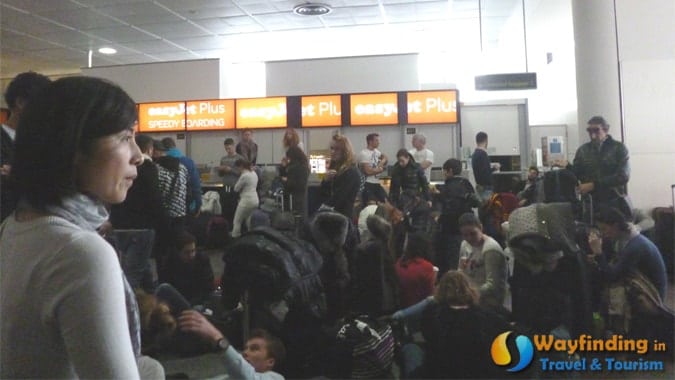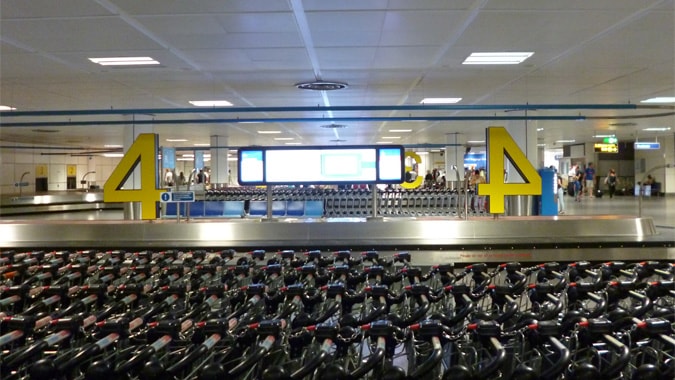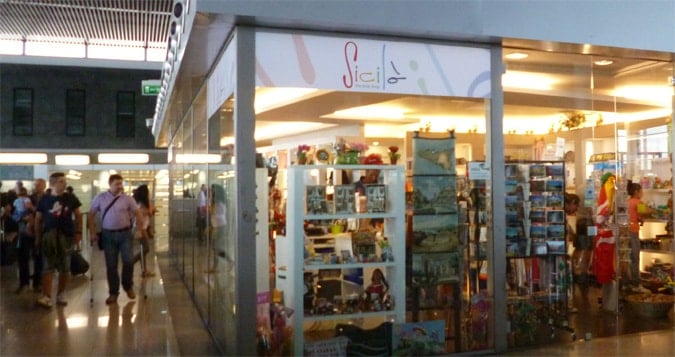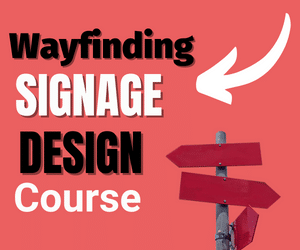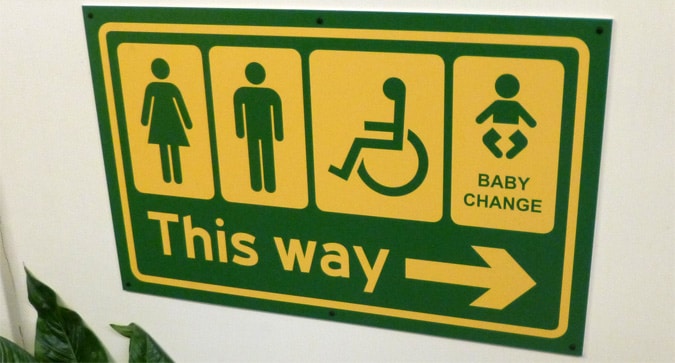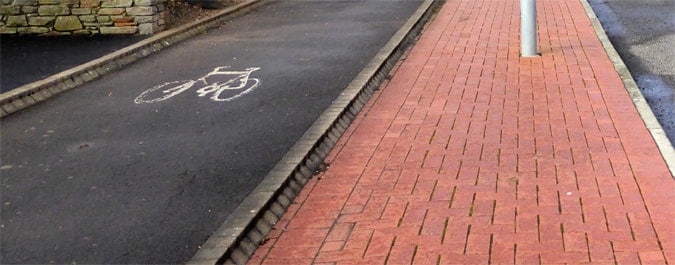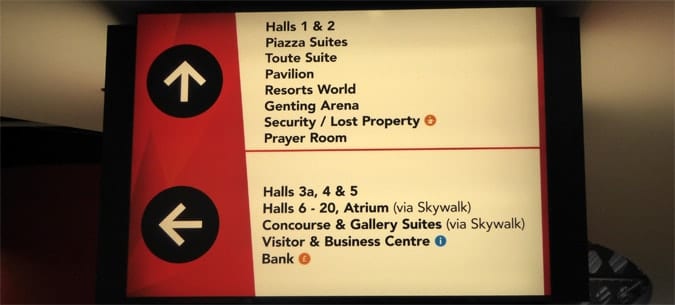Last Updated on June 14, 2023
In the latest of our case studies, we look at Bristol Airport wayfinding.

Bristol Airport, in England, has recently undergone a big transformation with the re-development of its main departures terminal, with an £8 million-plus (roughly US$12 million) renovation, which offers fliers more facilities and a greater space within the airport.
Having used the airport so many times in the past, I was curious to see how the new terminal had improved and how the airport has developed.
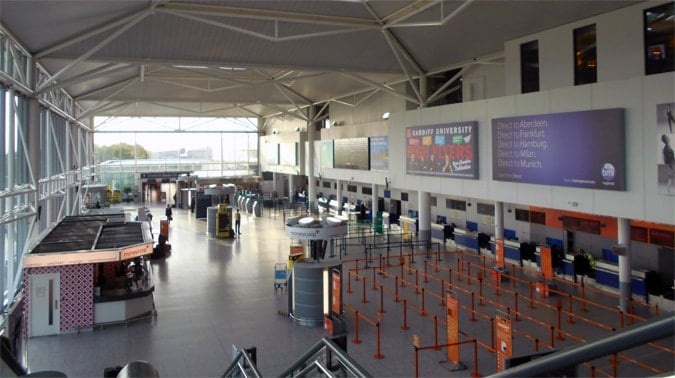
The airport is one of the fastest-growing in the UK and they do offer a very good number of routes across Europe, easily dominating the market in the south-west of England.
Cardiff and Exeter airports, and offering a gateway into the UK for South Wales, Devon, Cornwall and Somerset, but cannot compete with Bristol.
Bristol Airport continues to grow and evolve, thus it was interesting to see what had changed in terms of wayfinding
Table of Contents
Parking at Bristol Airport
When I first started using Bristol Airport many years ago, I started using the Silver Zone Parking service, a parking lot roughly 4 minutes from the main terminal and for which a frequent and free bus is provided.
You do have to hand over your car keys but overall it is a very reasonable cost and well-organised service.
But then over time, I decided to start using the slightly more expensive parking directly in front of the terminal.
This worked well and we often parked almost directly in front of the terminal.
But over the years, as this service became more and more popular, we found ourselves having to park further and further away, to the point that we found ourselves parking much further from the terminal entrance, having to park very close to the main road entrance to the airport.
We found that parking in the silver zone would actually be as fast, easier and certainly cheaper!
And now it’s Silver Zone for us, given the difficulties we started often to experience in the main terminal parking.

Lack of Time
In wayfinding, one of the tricks is to move people efficiently and fast and, for airports in the UK, the ability to get people through to the departure lounge areas, normally means the chance for an airport to push commercial sales.
Help a traveller to feel relaxed, help them to get through security and to the departures area smoothly and with the passengers relaxed rather than stressed, and, as studies have shown, passengers are more likely to spend.
The situation is that stressed passengers are less likely to want to roam around the shops and facilities because they will want to limit the further risk of stress through getting lost and getting further confused.
Bristol Airport is not alone though in the problem of struggling to allow passengers enough spending time.
Because of the time limit from when you can check-in, my wife and I have never ever had enough time to relax and to see and do what we have wanted to do after security, in departures.
Because an airline such as Ryanair call passengers quite early, in order to make sure all passengers are in the boxed holding area ready to board as soon as possible (understandably), you often only have 30 minutes to order a meal, if you are having one and to eat, and sometimes no time to shop.
On one of our flights a few weeks ago, we were lucky to even to board the plane at all (this was not a typical situation though).
With the Ryanair computers (they were working for other airlines) down and checking people in not possible, passengers were queuing for Desk 45, stretching all the way back into the main terminal area.
After one hour of failing to get the computers working, the decision was made by someone in Ryanair to start manual check-ins and eventually, we were checked in and through security.
I decided to pop into the WHSmiths during the wait, whilst my wife kept our place in the queue, but a line was also forming in WHSMiths with the self-pay tills broken and no human cashier available.
The lady in front of me had 3 books in her hand and, after several minutes, she gave up and put the books down and walked off having given up on her purchase.
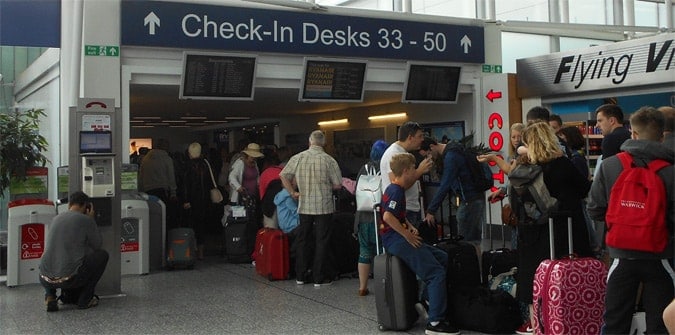
The next problem occurred because the brand new signage system in the new terminal sends you the wrong way (perhaps intended by the airport) and steers you past all the new facilities, but the question this raises is – will a frustrated passenger or a relaxed and happy passenger be the most likely to spend in the airport or any airport come to that?
With different signs telling you two different opposite directions to get to the same departure gate, it becomes somewhat confusing and having taken the wrong option of the two choices, we were even more panicked in trying to get to the departure gate for Gate 12.
The need of airport owners to do all they can to maximise sales and awareness of the different facilities is understandable, yet forcing people to take long routes unnecessarily can also frustrate users and also lead flyers to sometimes consider avoiding a certain airport.
The determination of Ryanair to get the plane out on time meant that we experienced yet another rush through Bristol Airport and with not enough time to spend.
In this experience the effort made by the airport to send me on a much longer route through the airport was actually what stopped me from having any time to spend money, which seems quite ironic.

What’s Good
Using Humans for Wayfinding Guidance
Before mentioning other negatives, I would like to mention some of the good things that Bristol Airport are also doing, in what it is fair to say is a work in progress.
With increasing passenger numbers and a range of routes that neighbours Cardiff Airport can only drool over, Bristol Airport is clearly doing a lot of things right at the management level too.
In terms of wayfinding, one nice touch to coincide with the newly refurbished terminal is the use of a people helper.
The world of customer service is going full circle in many locations and in many travel situations.
National Express got rid of servers on their buses in the 1980s and yet Megabus has gone full circle and now offer waited for service on their buses.
Bristol Airport, on the other hand, has copied the retail model of introducing real humans to help those in need of help with directions and other guidance (as we now see in many large supermarkets), with a people helper as shown below.
At a time when many commercial locations are forcing the user to do even more work (such as the hugely frustrating self-service tills), many other commercial locations are already realising that you cannot de-humanise the experience and that this is actually the opposite of what you need to achieve.
(Update November 2015 – the human wayfinding helper seems to have disappeared now).

Use of Space
The new facilities themselves (new bars and restaurants and relaxation type areas) and the use of space, I have to say, looks very nice.
I just need to be given time to enjoy it in the future without being in a constant rush (even though I always arrive more than two hours before check-in but have to wait before I can go through security).

Special Assistance
Making travel something that is possible and accessible for all people, no matter what one’s ability or disability, is important from an ethical point of view as well as a certain right as an air traveller (see the European Regulation 1107/2006).
Bristol Airport does seem to make a good attempt at helping wheelchair-bound passengers and those with mobility needs, to help this group navigate through the airport.
With a ‘Special Assistance’ desk in the main check-in area, clear and detailed special assistance information easily found via the bottom of their website homepage and with wheelchairs strategically placed within the airport, such as at the starting points of the long walkways to and from the planes, helping passengers in this respect, is taken seriously.

The peculiar thing, after seeing the strong attempt to cater for those with mobility needs, is contrasted with what seems a peculiar message.
With more than 350,000 registered blind or partially blind in the UK, having an electronic departures board with a notice on it saying
“Boarding announcements are not made at Bristol Airport, please check the flight information screens“
goes very much against the needs of those with sight problems. See, on this topic, studies by the likes of Small et al (2012).

Teething Problems. What could be improved
Signage Problems
Some of the teething problems are quite common mistakes in wayfinding design and are easily fixable.

The difficulty to read signage from a reasonable distance is not only an issue experienced by those with sight problems.
Signage that is placed as white text on a grey background can be a recipe for disaster in terms of signage design, as shown above.
Most of the signage in the airport fulfils best practices, but some new signs have popped up in the airport which is difficult to read because of the wrong colour backgrounds on the signage.
The problems continue if you walk through the new part of the terminal and then move to the next floor up, via the escalator.
Reach the top of the escalator or stairs and you might be as confused as what we were.
The simple problem was that, at the top of the stairs, there is no sign clarifying (no confirmational sign) to confirm that this is still the right way to go for the terminals 8-34 because it is only when you turn around at the top that you then see the sign.

Halfway up the stairs, we were about to walk back down again because of the uncertainty as to where to go.
The placement of signage in wayfinding and putting such signage at the key decision points is essential and, when not done correctly, creates confusion among passengers.

Some of the signage is also designed with room for improvement, given that some standard conventions in the design are missed.
The sign above, for example, can easily be improved and, whilst these changes may seem somewhat pedantic, they are known to make a difference.
We come across so many signs in airports that every detail begins to matter.
- Arrows on signage should never point into the text but should point away from the text.
- Similar or related items should always be grouped together to make signage even easier to read. When you consider the number of signs in an airport, every small improvement can aid the user’s experience. In the sign below, ‘Toilets’ and ‘Baby Changing’, for example, should be grouped together and NOT separated by ‘Cash Machine (ATM). This is a common mistake in wayfinding signage design.
- Consistency. It is also a common mistake to create confusion or to be inconsistent with terminology. The use of the American English term ‘ATM’ is logical but, if being used to tackle American English terms, then ‘Toilets’ should also be listed as ‘Restrooms’ in brackets. They key is to be consistent with signs.

Forced Wayfinding rather than Subtle Steering Behaviour
One of the biggest frustrations of many travellers in Bristol Airport, unfortunately, remains, despite the upgraded departures terminal and new extra spaces and facilities.
The dreaded forced walk through the winding Duty-Free area of the airport, through which you must walk, whether you wish to or not, to go from the security area through to departures.
If you have ever walked with young children who are curious, through an area with glass bottles of alcohol, perfumes, an area through which your route is often blocked by other travellers or staff, it is a frustrating and unnecessary forced route for many travellers and one which I often hear highlighted as the biggest problem with this specific airport.
‘Steering behaviour’ though which is too forced, can be counterproductive.
People who have the chance to relax, easily find their way and be steered in a more subtle manner, are more likely to spend more and, importantly, to return and re-use the airport.
There is another side though to this issue though in that airports have to be commercially viable and Duty-Free areas are cash cows and vital in how airports make themselves financially viable.
This is accentuated by the increasingly lower fees that airlines are willing to pay airports per passenger, the costs driven down by budget airlines such as Ryanair.
The income from this forced wayfinding in this respect is understandable and needed in many UK airports if we want these airports to thrive and to provide us with more flight routes into local airports.
The balance for airports is between commercial activity and LOS (Level of Service) and is a difficult balance.
Other Signage Considerations – Bristol Airport wayfinding
Bristol Airport is actually a lot better than many airports and other travel hubs when it comes to signage and wayfinding.
It has been used though, just to give an example of a typical travel hub issue.

Conclusion
Overall, it is wonderful to see Bristol Airport wayfinding expanding and introducing new facilities. There are still teething problems though and some of the pet hates of some travellers still remain.
Arrive back into the airport and there is nowhere to eat a decent meal before starting your drive home, be it to Plymouth, Swansea or Cornwall for example.
There is no Wetherspoons or similar, which you find in airports such as Gatwick and Heathrow, which you can use as an arriving passenger.
The question I always ask myself is why do Bristol Airport always make it hard for my wife and I to spend money there?
Overall though, I love the airport and they have a really good set of routes for European journeys.
Given that I have used them as a case study, it is only right I also in fairness give you the chance to go directly to their site, so that you can see the list of routes from Bristol Airport – click here!.
References
- Small, J., Darcy, S., Packer, T., 2012. The embodied tourist experiences of people with vision impairment: Management implications beyond the visual gaze. Tourism Management 33, 941–950.
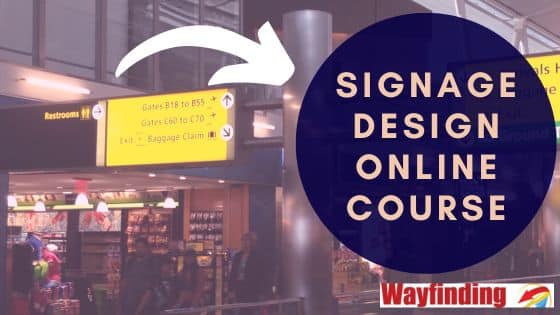
Dr Paul Symonds has a PhD in Wayfinding from Cardiff Metropolitan University in the UK. Paul works with the signage industry, airports and other locations providing wayfinding audits, consultancy and training.


